Croatia
Basic Data
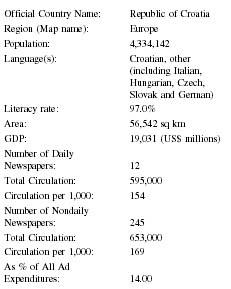
| Official Country Name: | Republic of Croatia |
| Region (Map name): | Europe |
| Population: | 4,334,142 |
| Language(s): | Croatian, other (including Italian, Hungarian, Czech, Slovak and German) |
| Literacy rate: | 97.0% |
| Area: | 56,542 sq km |
| GDP: | 19,031 (US$ millions) |
| Number of Daily Newspapers: | 12 |
| Total Circulation: | 595,000 |
| Circulation per 1,000: | 154 |
| Number of Nondaily | |
| Newspapers: | 245 |
| Total Circulation: | 653,000 |
| Circulation per 1,000: | 169 |
| As % of All Ad Expenditures: | 14.00 |
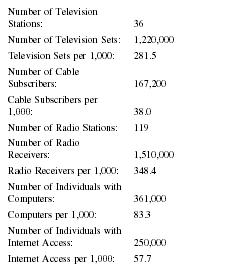
Number of Television Stations: 36
Number of Television Sets: 1,220,000
Television Sets per 1,000: 281.5
Number of Cable Subscribers: 167,200
Cable Subscribers per 1,000: 38.0
Number of Radio Stations: 119
Number of Radio Receivers: 1,510,000
Radio Receivers per 1,000: 348.4
Number of Individuals with Computers: 361,000
Computers per 1,000: 83.3
Number of Individuals with Internet Access: 250,000
Internet Access per 1,000: 57.7
B ACKGROUND & GENERAL
Characteristics
At the beginning of the twenty-first century, the state and future of the Croatia's media can be viewed in the context of two defining events. The first was the end, in the early 1990s, of the socialist period of government that lasted 45 years following the end of World War II. The second event was the effect of the ethnic conflict in the Balkans from 1992 to 1996, followed by the peacetime influence of the government of President Franjo Trudjman from 1996 to 1999, which ended with his death on December 10, 1999. Consequently, Croatia's media have been moving out from under the heavy control and influence of the government toward independence and autonomy. It is this movement that characterizes Croatian media today and guides its evolution in the twenty-first century.
The media in Croatia are delivering news and commentary to a highly educated, literate population that values news and debate in the early 2000s. Notwithstanding a population that has a low per capita income by European standards of US$4,000 per annum in 2001, there are numerous media and a wide range of political positions among them. A distinct concentration of media is in the capital, Zagreb, in large part due to the concentration of population in the city and in the surrounding region. According to the 2001 census, the population of the city of Zagreb was 770,058; however, coupled with a population of 304,186 in the surrounding county, the Zagreb metropolitan
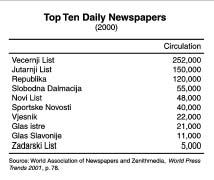
The quality of journalism would generally be scored a 7 out of 10. Much of the poor journalism can be attributed to journalists who historically worked under the former socialist system and who are often not trained as journalists and have acquired and maintained their positions through political patronage and their willingness to deliver a loyal party line. Many of these journalists have shown an inability to adapt to a more critical, wide-ranging, issue-oriented role after the end of the socialist government, and as such, the quality of journalism suffers. In contrast, journalists who were not trained under the socialist system and were at the forefront of the criticism of the government during the Balkan conflict have created a class of critical writers and observers that provide perceptive commentary on the situation in the region. With the increasingly open media, this type of journalist is in the ascendancy.
Most newspapers are in a tabloid format with over 50, and sometimes up to 70, pages in length. The exception is the newspaper Vjesnik, which is regular size. National, regional, and international news dominate the first one third of the newspapers, features and television programming the middle third, with the final third devoted to weather, sports and cultural topics. Newspapers retailed for less than US$1 in 2002. Sunday newspapers

Other cities in Croatia do not have significant competing newspapers; rather, national papers tend to have regional specialization. For example, the national newspaper Slobodna Dalmacija exhibits a regional coverage bias in favor of the Dalmatian coastal region containing the second-and third-largest cites of Split (population 300,000) and Rijeka (population 225,000). Official circulation figures of newspapers are unobtainable and vary widely depending on the source, but it is believed that the most important newspapers by unofficial circulation figures are: Vecernji List (120,000), Jutarnji List (90,000), Slobodna Dalmacija (30,000), Novi List (15,000-20,000), and Glas Slavonije (a regional Slovenian newspaper; 10,000) and Vjesnik (8,000).
Although Vecernji List and Jutarnji List are the highest circulation news-related publications, numerous popular publications also exist, including Gloria, a weekly magazine specializing in fashion, yellow journalism, and personalities, with a circulation of 90,000; Globus, a weekly similar to Gloria with a circulation of 70,000; and Teen and OK, teenager magazines with 55,000 and 50,000 readers, respectively. Additionally, the fashion weekly Mila, the political weeklies National and Arena, and the fashion monthly Cosmo also outsell one of the largest newspapers, Slobodna Dalmacija. Three other publications are noteworthy: Autoklub, a monthly motoring magazine, has 30,000 readers; Playboy magazine, with 22,000 subscribers, outsells the fourth and fifth bestselling newspapers; and the weekly Feral Tribune, with 20,000 copies in circulation, is noteworthy as it was the most vocal critic of the Trudjman regime in the 1990s. Although the Feral Tribune fell on hard times in large part as a result of ongoing legal judgments passed down on the basis of lawsuits filed during the Trudjman era, it remains one of the most outspoken publications in Croatia.
Economic Framework
The economic climate of Croatia is a direct result of the repercussions of the Balkan war and the rule of President Franjo Trudjman, which lasted until 1999. The ravages of war have meant that recovery has been slow, a pace that many independent media have blamed on continuing government corruption and mismanagement. A change of government following the death of Trudjman has resulted in little improvement. In contrast, the neighboring country of Slovenia, although less affected by the Balkan war, has made significant economic progress. Progress in Slovenia is such that it has become a viable candidate for European Union membership, a status many in Croatia would like to achieve. The result of this economic climate has been a more vigilant press, intent on exposing corruption and mismanagement and generally critical of the nation's economic progress. This role has been confined to the printed media because the national television and radio networks are still government controlled and hence muted in their criticism. Much internal and external media criticism has been directed at government control of the television network, which serves as the primary source of information for an estimated 70 to 90 percent of Croatians; over 50 percent obtain their news from television's early evening news program.
In contrast to the television network, all newspapers are owned either by individuals or large corporate bodies. Indeed, the acquisition of most Croatian newspapers by two corporate giants, Europa Press Holdings, a German conglomerate, and Styria, an Austrian based media conglomerate, has lead to fears that Croatian media has gone from being de facto government controlled to corporate controlled. The Croatian government is expected to address such potential monopolistic issues in the future. The newspapers that exist can be characterized as a mixture of popular and yellow journalism. This reflects not only the need to impart the news but also to build circulation, which provides the justification for inclusion of yellow journalism. The only exception to this group is Vjenik, which is much more elitist. As the former organ of the ruling party, it has fallen to fifth in popularity but its articles are longer and more in depth, and it is generally agreed that the quality of the journalism and its increasing distance from one-party affiliation will make it increasingly more popular and accepted, leading to a rise in circulation.
A major issue in Croatia is the print media's near monopolistic distribution network, owned by the Tisar company, which controls distribution, including most of the kiosks where print media are sold. Tisar's uncertain financial situation was of major concern beginning in 2000. In the early 2000s the company was acquired by Europa Holdings, resulting in renewed concern over too much vertical integration within the media.
Unlike many other countries, newsprint is readily available to all who wish to publish, and there are a large number of private printing houses with modern offset printing presses. Hence, control of print production is not an issue. Moreover, there have been no strikes or work stoppages in either the journalistic community or the printing community that have affected media production. Wages in the media are on a par with the national average; however, a difference does exist between employees of the state-controlled television network and the print media. Notwithstanding a large bureaucracy and a situation of over-staffing, television network salaries are always forthcoming and relatively inflation proof. In contrast, in the print media circulation wars are ongoing and staffing is a critical cost area; thus, journalists are often paid only a small retainer and receive a bonus or commission based on the story they obtain or, more problematic, on the degree of sensational impact the story has on the publication's audience or overall circulation. Sales and circulation as a source of revenue is particularly important because advertising in Croatian national newspapers is very limited (usually less than 20 percent of the newspaper and often less than 10 percent), and most advertising dollars are generated by multi-national companies or commercial endeavors placing classified ads. This lack of local advertising revenue can be attributed almost solely to the lack of marketing funds for most Croatian
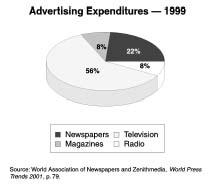
Press Laws
The constitution of the Croatian Republic guarantees freedom of the press and freedom of speech. Specific laws governing the press uphold these rights but identify such subjects as pornography, official state secrets, and obscenity as areas where censorship is imposed. However, as subsequently noted, the constitutional right and ostensibly liberal publishing laws has not stopped extensive litigation, particularly slander suits, by politicians. For example, a cartoon depicting a person urinating was the basis for a lawsuit citing the cartoon as pornographic material. The existence of more restrictive press laws and their use to restrain journalists was certainly more prevalent under the reign of President Trudjman. For example, a law under the Trudjman regime made it a penal offense to criticize the president and five other members of the executive branch of government. This law has now been repealed, but the sentiment that it expressed is still prevalent under the existing government. As much of the judiciary is appointed by the government, it is generally agreed that the courts are more sympathetic to the plaintiff (in cases of newspapers being sued for libel). In general, the Croatian courts are more likely to consider libelous reporting as serious offenses, suits that in the European and American press would probably be considered trivial or without foundation and thrown out of court. In two of the decisions handed down in 2002, the daughter of a prominent politician was awarded 100,000 kunas (US$12,000.00) for suffering "mental anguish" after a journalist negatively criticized her sculpture, and the Feral Tribune was fined 50,000 deutschmarks for causing "moral pain" to a plaintiff in a 1994-1995 lawsuit. As a counter balance to the press laws, the Croatian Association of Journalists maintains a 10-member council that monitors journalists and may pass nonbonding judgments on their ethical behavior and their newspapers.
Censorship
There is no official government body that monitors the press and no official censorship. However, considering that there were some 10,000 cases pending against journalists before the courts in 2002, the court system serves as the major source for policing the media. If a journalist loses a case, imposed fines can be high (and journalists' private bank accounts have been raided to pay these fines). Because of their meager salaries, journalists have a large incentive to avoid the courts and thus self-censor. In addition, the fact that many official agencies are still government-owned and yet to be privatized has meant that journalists guard their official sources closely. The prevailing policy might be described as "not biting the hand that feeds you."
There are, nonetheless, a significant number of examples, both during the Trudjman era and after, in which the power of the press to influence public opinion and indeed to cause general outcry against perceived wrongs has been such that dramatic change has occurred. For example, the resignation of the former mayor of Zagreb was a direct result of the media's exposure of the fact that he left the scene of a car accident while intoxicated.
State-Press Relations
The most significant feature of state and press relations is the paradigm change from pre-1990 when, under the socialist regime, the media was purely a tool to disseminate state and party information, to the post-2000 era when journalists are free to write what they wish. For the political elite this change is difficult to accept. As a result it is generally the political elite that become offended when even mildly criticized by European standards, and it is primarily they who have launched the large number of lawsuits alleging slander, defamation of character, and the like before courts in the early 2000s. The effect has been that the newspapers have been forced into lengthy, time-consuming and costly court battles to defend freedom of the press whereas the government has seen this as an effective way to stymie the press. Given the precarious financial state of some publications, it may ultimately have the effect of removing some small independent media voices. Acting as a counterforce to this government legal pressure are organizations such as the Organization on Security and Cooperation in Europe (OSCE) and International Research and Educational Exchange (IREX), whose responsibilities include the monitoring of government interference in the media and recommending legislative change to create greater freedom in the media.
Attitude toward Foreign Media
The Croatian government is generally tolerant of foreign media. There are no special requirements for foreign journalists in Croatia, and certainly there have been no restrictions placed on journalists or foreign correspondents. This was not entirely true under Trudjman, who often railed against the foreign press, but since his death this kind of diatribe has ceased. It must be noted that the ever-widening connection to cable systems and satellite transmissions has made foreign reporting even more available, and CNN is now considered the de facto voice of the U.S. government voice in Croatia. Under the IREX program of USAID (U.S. Agency for International Development), widespread dissemination of cable systems has been provided, and the office closely monitors the various government policy and legislative measures that affect the provision and functioning of an independent media. It may serve as a measure of the dramatic change that has occurred in the media since the death of Trudjman to observe that U.S. assistance in the provision of an independent media has changed in the new millennium from a focus on training journalists in investigative reporting, media law, and avoidance of libel to one of business practices and financial management. In addition to the United States, the European Union's Council of Europe has sent a number of delegations to Zagreb to recommend changes to laws governing the media and in particular those laws that relate to changing the state-owned television and radio network into an independent public broadcasting system.
News Agencies
There is one domestic news agency, the Croatian News Agency (HINA), that acts as the official government voice. It is generally considered reliable and all print and electronic media and correspondents both in Croatia and overseas use its releases. The usual companies represent foreign news agencies: Associated Press, Reuters, and Agence France-Presse. APAD, the Russian news agency, like a number of other agencies, covers Croatia from Belgrade. The government does not receive foreign news agency wires and hence news outside Croatia usually emanates from International News services.
Broadcast Media
As was previously noted, the state controls national television and radio. Three channels are broadcasted: one devoted to sports, the second to entertainment, and the third to news. An independent board supposedly guides the national network, but in fact programming directors and producers have significant autonomy and produce programming that is very pro-government in orientation. However, some liberalization has occurred during the early 2000s. For example, those critical of the government and who would not appear on television may now be seen and heard.
Electronic News Media
Like in many other nations, the Internet is only now becoming widely accessible owing to the falling cost and availability of computers and the ability of the telecommunications network to handle Internet traffic. Anecdotal reports suggest that approximately 10 percent of the population have personal computers, but there are 290,000 Internet users, mostly available at Croatians' employment sites; thus, there is increasing access to online news flow. During the Trudjman era, the Internet was a major medium for dissent and protest over curbs on the media, but the gradual liberalization of the media since 1999 has meant that the Internet is no longer primarily a protest vehicle.
Education and Training
The only school of journalism in the country is at the University of Zagreb. The school graduates approximately 100 journalists each year, and there appears to be a strong market for graduates as most find employment in the numerous newspapers, magazines and electronic media. More prevalent is the situation where university graduates seeking employment are hired by someone they know in the media. The Croatian Association of Journalists upholds the status and stature of journalism in Croatia. It acts as an oversight body, a refuge against threats from outside, and as a representative body for journalists. The association has a yearly awards program that recognizes and promotes excellence in journalism.
In recognition of the difficulties Croatian print media had establishing independence during the Trudjman era, The Feral Tribune received a number of international awards from international press institutes for their pursuit of press freedom.
Summary
In the last 10 years of the twentieth century the media in Croatia was placed in an invidious position. From 1992 to 1996 a "homeland defense war" was conducted against its neighbors Serbia and Bosnia-Herzegovina. The media was, of necessity, required to state its allegiances, and these positions were essentially set for the decade. It created a situation where growth of the fourth estate was stunted by the necessity to remain nationalistic and in some cases jingoistic in order to retain an audience
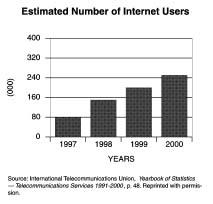
The prognosis for the development of an independent, vibrant media in Croatia appears promising. Like many European countries outside the European Union, the prospects for Croatia obtaining membership in the Union is highly dependent on the state of the govern-ment's relations with the media. In this regard, the pressure being exerted on the government by the European Union, and the positive reaction by the present government, in contrast to the Trudjman era, would appear to bode well for the media. The presence of the large number of outstanding litigation cases before the courts is not only a serious constraint to the development of the present media but also to the development of an independent media in the future, not only because of the legal issues involved but also because the motivation for such lawsuits is based on a fear or distrust of the media by the political elite. The value of and need for an independent media has yet to be realized by the powerful elite in Croatia. Journalists perceive that after the problems of the Trudjman era things are getting better, although many believe not enough has changed. They point out that economic
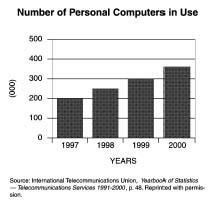
Significant Dates
- 1992-1996: Balkan Conflict. President Trudjman attempts to control the media in efforts to bring about strong nationalism. Independent News media strongly criticizes the conduct of the war.
- 1999: President Franjo Trudjman dies.
Bibliography
Croatia 2001 World Press Freedom Review. Available from http://freemedia.at/wpfr/croatia.htm .
"The Media in the Republic of Croatia: Facts and Information." Zagreb: State Publishing House, 1998.
"Report on Public Affairs and Media." Organization for the Security and Cooperation in Europe. Available from http://www.osce.org .
"Country Reports on Human Rights Practices 2001." U.S Department of State. Available from http://www.state.gov .
Richard W. Benfield
Are commercials sent, or is TV publically funded?
TV stations: 21
Radio stations: 136
Daily newspapers: 11
Online general news media (part as media outlets online brands, part independent): 120